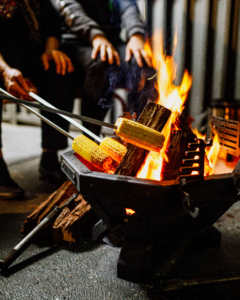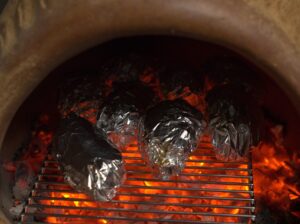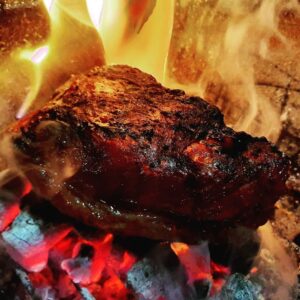All Posts
4 Ways To Cook on an Open Fire and the Best Food To Go With It
Cooking on an open fire is always exciting, and there’s no better time to light up that outdoor fire pit than on cold winter nights. The definition of open fire cooking is pretty self-explanatory: you use a variety of cooking methods for the outdoors over an open fire typically made using firewood.
With the right kind of fire pit and fuel (check out the Firebrand Vintage QLD Ironbark here), you can quickly get a hearty fire going and prepare a satisfying meal for yourself and your loved ones. Here are some of the best ways to cook using this method, along with the types of food you can cook.
Use a skewer.

One of the simplest ways to cook over an open fire is by using a skewer. Use it for s’mores, sausages, corn on the cobs, or kebabs! Try the Tramontina 6 Piece Skewer Set, with handles crafted from wood to safely roast your meat, seafood, and vegetables over a fire. Or use a grill or rack to hold your ingredients.
Ready to try? For inspiration, check out our Chicken Beyti with Fresh Garden Herb kebab or Barbecue Prawns in Curry Sauce recipes!
Use a cast iron skillet or Dutch oven.

Open fire or not, owning a cast iron skillet or a Dutch oven is a must for all cooks. Cast iron is one of the best conductors of heat, as it distributes and retains heat for long periods of time to ensure food stays warm until you finish preparing all your food. Beginners will also find these easy to use for outdoor cooking since they can control the heat without difficulty compared to cooking directly in the fire.
The Napoleon Professional Cast Iron Skillet is perfect for first time users. It’s easy to season, and the removable handle stays cool while cooking, engaging and disengaging quickly for moving and removing food.
For a heavy duty Dutch oven, try the Napoleon Cast Iron Dutch Oven. Many open fire recipes are prepared in this cookware, like chilli, stews, and flavourful braises. You can even bake bread in it!
For recipes that you can make using cast iron cookware, check out our Asian Style Braised Short Ribs!
Use foil packs.

With aluminium foil, you can make various meals on your firepit with minimal cleanup. Foil cooking makes ingredients like potato and salmon retain moisture, so you can cook dishes with liquid (butter, eggs, or sauce) without making a mess.
Making a foil pack to cook over fire is simple: place your ingredients in the middle of the foil, bring the edges together and crimp and fold tightly so that steam does not escape. This makes your meat juicy and your vegetables well cooked. Put over your grill or rack or place directly over the embers.
There’s usually no need to flip the foil packs. Once your meal is cooked through, you can serve it straight from the pack for fewer dishes to wash!
For premium quality foil, check out Firebrand Foodservice Foil. Use it for prepping, wrapping meats during low n slow cooks, and cooking over open fire! For an easy peasy foil pack meal, check out our BBQ Whole Fish!
Cook directly on coals.

When combining firewood and hardwood charcoal for open fire cooking, it is possible to cook directly over coal. This is great for meats – the hot coals sear the meat and create a smokey, crispy crust that will prevent the coal from sticking to your food. For caveman steaks, a dry rub can protect the meat from charcoal.
Make sure to use natural chunk charcoal so that wood is the only ingredient that touches the meat. Try the Firebrand Professional Hardwood Lump Charcoal made with all natural, single origin citrus hardwood.
You can also bury whole large veggies like pumpkin and sweet potatoes in embers and let them cook until tender. Depending on the vegetable, it could take an hour or more. Once done, dust the ash, and it’s ready to serve!
Keep your fire consistent
Whatever way you choose, wait for the wood to burn down to embers to get a strong, consistent heat. To test if your fire is ready for cooking, try this: put your hand near the fire. If you can hold it there for three seconds or less, your fire is in high heat. Medium high is at around four to five seconds, medium is at six to eight, while medium low is at eight to 10. Low heat is at 10 to 12 seconds. If you can hold your hand near the fire for longer than 12 seconds, it’s not hot enough for cooking.
Remember: control the fire instead of letting it control you. You’re aiming for slow, steady cooking, so patience is key. Once you’ve done that, you can sit back and enjoy your barbie!
Wondering what type of fuel to choose for your grill? Click here for our guide.
